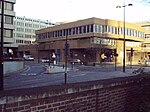1807 Newgate disaster
1807 disasters1807 in LondonFebruary 1807 eventsHuman stampedes in the United Kingdom

The 1807 Newgate disaster or the Old Bailey Accident of 1807 was a human crush that occurred outside London's Newgate Prison on 23 February 1807. The disaster occurred when part of a large, dense crowd gathered to witness a triple execution destabilised after being disturbed by a collapsing wooden cart, which triggered a chain of events leading to a fatal crowd crush. Many fatalities and severe injuries resulted, with newspapers reporting that at least 27 perished in the accident and one observer counting at least 34 dead.
Excerpt from the Wikipedia article 1807 Newgate disaster (License: CC BY-SA 3.0, Authors, Images).1807 Newgate disaster
Hopton Street, London Southwark (London Borough of Southwark)
Geographical coordinates (GPS) Address Phone number Website Nearby Places Show on map
Geographical coordinates (GPS)
| Latitude | Longitude |
|---|---|
| N 51.5094 ° | E -0.1012 ° |
Address
The Founders Arms
Hopton Street 52
SE1 9JH London, Southwark (London Borough of Southwark)
England, United Kingdom
Open on Google Maps









